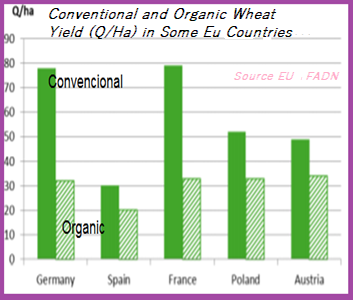Organic Farming with GMOs: The Double Advantage
Posted by Nazimi Acikgoz on 11/06/2022
The need to increase agricultural production in the near future is undeniable. Science has responded instantly to rapid changes in environmental conditions by developing the drought-resistant genotypes for this purpose.

With climate change, Central Europe is not only getting drier and hotter, but new genotypes (variants) of heat-loving diseases and pests are also reaching further north, to regions where they weren’t found before. So how can plant breeders deal with them? It takes many years to develop new, resistant varieties through classical plant breeding. Therefore, it seems inevitable that new strategies and new technologies will be introduced to develop suitable genotypes.
In recent years, with the expectation of quality life, human beings have turned to organic foods with 30-40% less product per unit area. The main reason why the yield per unit area in organic agriculture is low compared to conventional agriculture is that genotypes and varieties that will provide maximum yield in a limited nutrient environment have not been developed yet (Figure). The main reason why the yield per unit area in organic agriculture is low compared to conventional agriculture is that genotypes and varieties that will provide maximum yield in a limited nutrient environment have not been developed yet. Unless the “organic agriculture with organic seeds” condition, which is also included in the organic agriculture directives, is not met, the organic-classical yield gap does not seems to close[1].
The philosophy adopted while laying the foundations of organic agriculture was based on the principles that no one would say no to, such as protecting future generations, protecting soil and water, saving energy, not leaving chemical fertilizers and pesticides and protecting those working in agriculture. While the standards were being determined, non-GMO production, which was one of the controversial issues of that period, was added to the regulations. When we look at the historical course of the use of GMO varieties resistant to corn stalk worm, which started in the USA in 1996, we see that the pesticide, which was planted 200 g per hectare in 1996, fell into a state of not being used at all in 2010. The use of GMO varieties has increased to over 90% in the 2020s. This shows that when the GMO variety is planted, the use of pesticides is reset and at the same time, the agronomic performance is high. This phenomenon brings to mind the question of whether “organic farming of GMO corn” can be done, which eliminates the use of chemical pesticides and compensates for the yield loss in organic farming. While the gene that provides resistance to that rootworm comes from a bacterium such as Bacillus thuringiensis, which has been approved for use as a fertilizer in organic agriculture!
Both organic agriculture and agricultural biotechnology visionaries around the world have sought solutions to future food problems, arguing that some old and outdated guidelines should be renewed. For example, Tijeniro et al[2]. say “Genetically Modified Organisms Can Be Organic” and they state that there is no need to worry about economic, environmental, nutrition and food safety of GMOs in organic agriculture. Apart from this, it should be presented science-based information to consumers, explaining how GMO technology contributes positively to organic purposes and emphasize the added value of the use of GMOs in organic agriculture.
In this context, Bernard[3] touched on the following issues in his article titled “Is it possible with organic GMOs? Here are the scientific facts behind it’s a good idea”: the current policy that GMOs cannot be included in organic food production is outdated. Important researchers have shown the safety of GMOs in terms of health and environment. The legislation allowing the use of GMOs in organic agriculture and the policy on this issue should be changed. It would be appropriate to make seed production at the same standards in GMO and organic agriculture. Genetically modified organisms provide a sustainable solution to conventional farming by increasing crop yields and reducing the amount of pesticides and herbicides used. Therefore, GMOs should be allowed to fall under the definition of organic.
Let’s take a look at some facts:
• Drought-resistant transgenic maize (with GMO) has been registered. Does the farmer have a choice to produce organic corn in the arid region?
• The environmental benefits associated with GMO adoption are complemented by lowering the price of agricultural products. A few examples support the view that GM technologies reduce price;
• There are nearly 4000 varieties developed with mutations in the world. They are used in organic farming. However, cultivars developed by gene-editing-method such as CRISPR are not allowed in organic, purely because biotechnology is in effect as a method. Here, while the mutant varieties developed by irradiation method in laboratories are approved, the reason for saying no to varieties developed by biotechnological methods can be explained scientifically.
As a result, we have to embrace new technologies for the food security of tomorrow. In the first stage, it is necessary to enlighten society on this issue, and especially to inform the decision-making bodies.
Nazimi Açıkgöz
[1] Acikgoz N., and Ilker E. 2006 Cereal breeding strategies for organic and low-external-input crop production systems. Paper presented at Joint Organic Congress, Odense, Denmark, May 30-31, 2006
[2] https://journals.lww.com/nutritiontodayonline/fulltext/2021/01000/genetically_modified_organisms_can_be_organic.6.aspx
[3] https://geneticliteracyproject.org/2022/02/08/viewpoint-will-there-ever-be-organic-gmos-heres-the-science-behind-why-it-its-a-good-idea/
Leave a comment